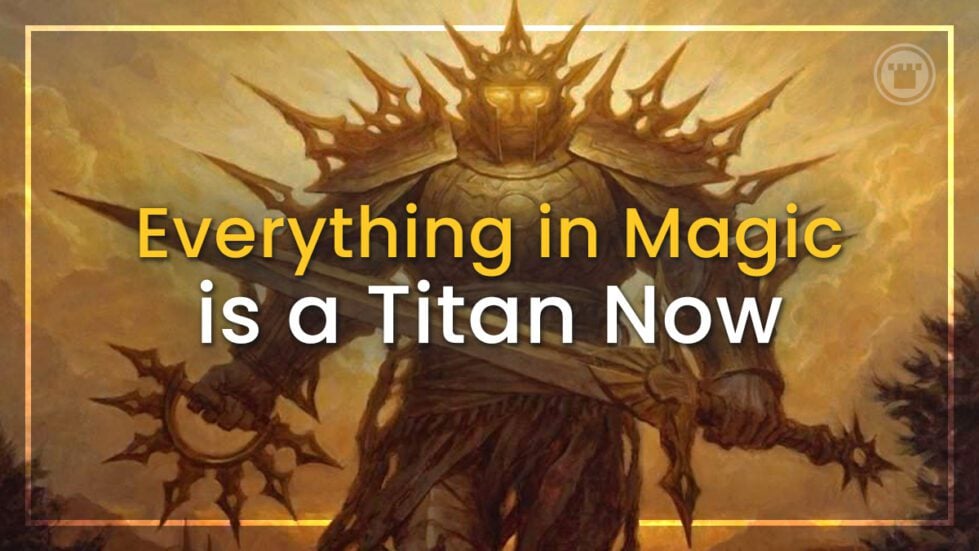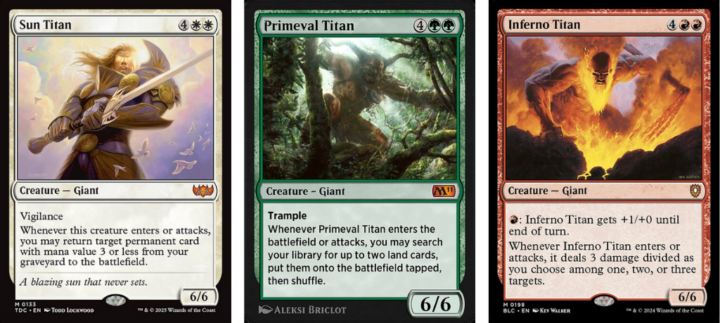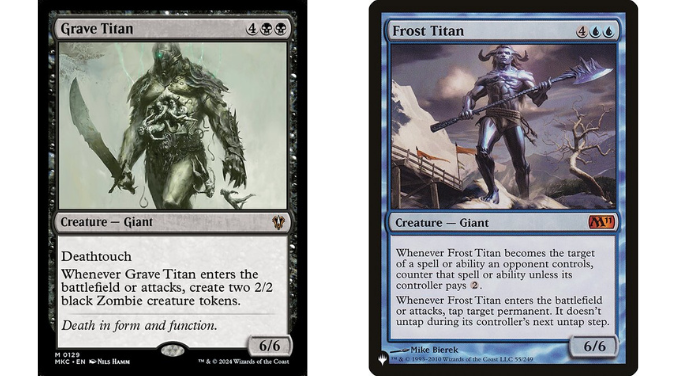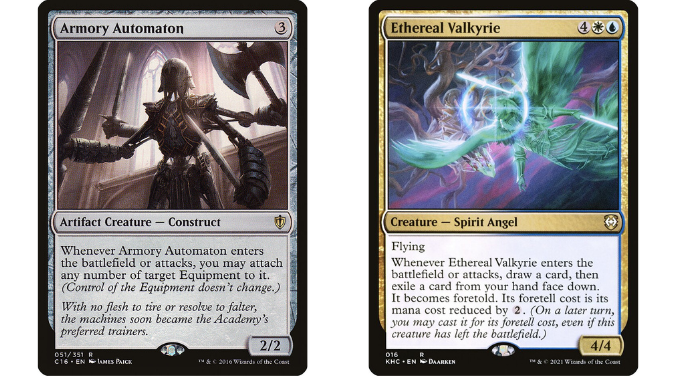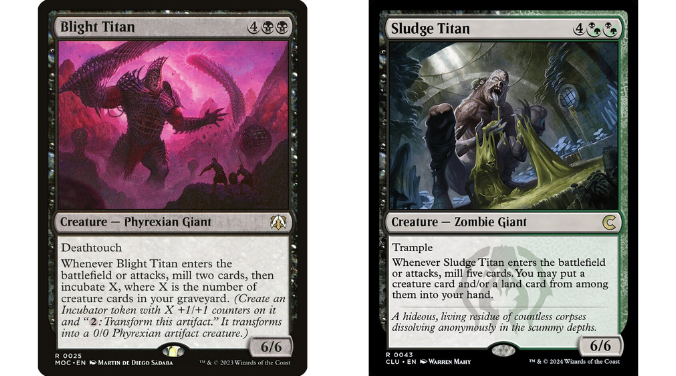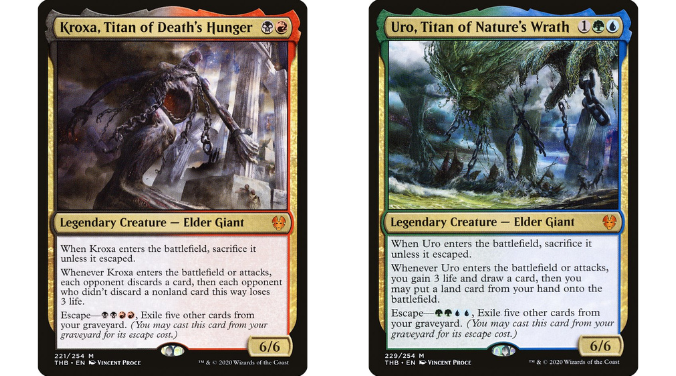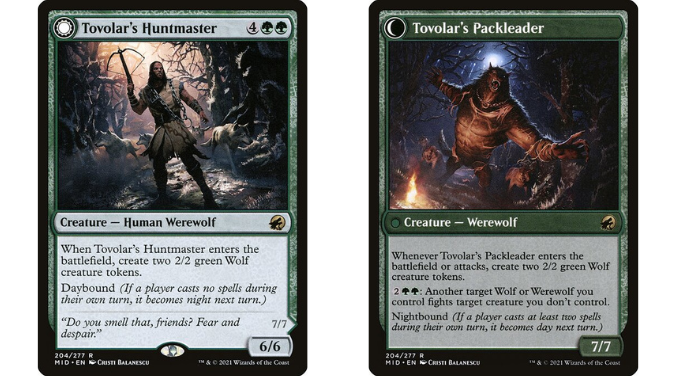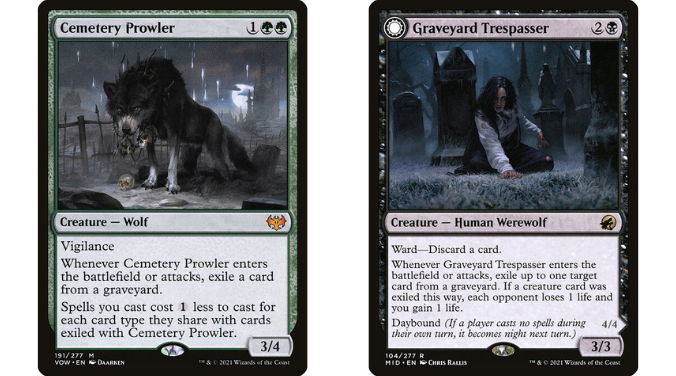Debuting in 2011, the Titan Cycle that includes Sun Titan and Primeval Titan would be a milestone moment for Magic: powerful creatures that do something when they enter the battlefield and when they attack. Since their inception, the shift in design toward creature-based Magic and to steadily increasing the power of those creatures sees us revisit that powerful “Enters or Attacks” text time and again. Is everything a Titan now?
ENTER THE TITANS
The titan cycle is one of two premier mythic cycles of M11, with the other being Planeswalkers. Planeswalkers themselves had shot onto the scene in Lorwyn four years earlier, and so much of the fanfare is around these Giant value engines.
Up until the 2010s, Magic had been a game that played as much on the stack, with instants and sorceries, as it did on the battlefield. Creatures were for attacking, primarily, and instant and sorcery spells had the big, splashy effects.
THE PIVOT TO CREATURE-CENTRIC MAGIC
A shift took place, though, and no card is more emblematic of that shift than 2014’s Siege Rhino, as detailed in this excellent write-up by fellow CK writer Jacob. While pretty decent EtBs were printed going quite far back, the game shifted to be much more about them as time went on. The focus was on people feeling like casting creatures was worth it, and to have creatures in play often, to make creature combat the main part of the game.
Creatures with an Attack and Enters triggers usually had separate triggers at this time, with one trigger being more relevant or stronger. KTK did toy with this particular design direction with Sidisi, Brood Tyrant, but the effect was still scarce, even a few years after the Titan cycle debuted.
It would be in Commander products that we’d see the first stones that started the avalanche. The enters or attacks text was either on very niche abilities, like Armory Automaton, or on creatures that needed you to have a board to benefit, like Bruse Tarl. Eventually in Kaldheim’s Commander decks, we’d greet Ethereal Valkyrie, and we’d chuckle. Hey, it’s the Azorious Titan.
It would take a good few years for us to see the true spiritual successors to the original Titan cycle, Blight Titan and Sludge Titan. These were true successors to the cycle, being both Giants, and 6/6s for six. While they are both solid role-players in the right build, one thing stands out about these two Titans: they arrived to very little fanfare.
What makes the original Titans the canary in the coal mine, and these latest Giants elicit nothing more than a “meh, seems alright?”
POWER CREEP IN MAGIC
Magic as a game is extraordinarily resistant to power creep, relatively speaking. Despite being a game for over 30 years, the power level of cards took a pretty long time to truly rocket off the ground. FIRE design was a methodology introduced in 2019, as a way to reduce the feels-bads for newer or more casual players who had their bomb creatures and planeswalkers being nuked from orbit by removal.
The long and short of it is that modern Magic cards are designed not only to reduce feels-bads (you’ll notice far fewer cards that fail on multiple axis of Quadrant Theory, for example), but also to satisfy the Best-of-One Arena format. Playing one game means you don’t need sideboards, and so interaction or indeed any card that’s slotting into a curve to enable a strategy needed to have failsafes, multiple modes, and contingencies in place so it wasn’t a dead card.
When we next got our 6/6 Giant “Titans” in 2020, they cost two or three mana, had an immediate impact when they entered, and then could be cast “properly” from the graveyard later on. These cards were very powerful, with Uro eventually eating the ban-hammer in Standard… but also in Modern and Pioneer, two formats with a much higher power ceiling.
The more powerful cards were getting, the more powerful the Enters and Attacks abilities were, too. And, in Modern and Commander, they started to appear more frequently. Archon of Cruelty is one of the strongest modern-era “Titans”, and it debuted in a Modern Horizons set.
Elsewhere, we had Ellivere of the Wild Court, now one of the strongest options for an Enchantress Commander available. Enters and Attacks is a powerful ability style, and it’s becoming more popular – and more ubiquitous – as time goes on.
EVEN STANDARD IS PROPAGATING TITANS
Perhaps one of the most identifiably “Titan” cards in recent years was Tovolar’s Huntmaster, which is functionally Grave Titan on the front side, but with a more powerful flipped backside. Ten years to powercreep Grave Titan is ostensibly okay, in my book – and it seems Wizards agrees, dropping this thing into a Standard format that was decidedly far less about six mana plays like Huntmaster.
The revisit to Innistrad featured multiple strong “Titan” cards, though, with many low on the curve and tempting players with adding them to their builds. Cemetery Prowler is one that I find particularly strong, and one I love to play in Commander, especially (which is probably why it’s a Mythic, let’s be honest).
As the years have gone on, we’ve seen “Titans” at increasingly low mana costs with increasingly more utility. Soul of Windgrace does a hell of a lot on one card, and actively enables itself, too.
Though narrow in the sense it only reanimates Vampires, Queen’s Bay Paladin is probably the closest comparison point to an OG Titan: Sun Titan. Sun Titan is similarly limited, but though the latter creature can ramp you, the Paladin is still a really strong card, even with the double downside of life loss and finality counter.
The true spiritual successors to the Titan cycle, though, are the Overlords from Duskmourn. The overlords are very similar to the OG Titans, providing similar color-specific benefits.
These ones have an interesting mechanic, Impending. You can cast them early to cash in on their ability, but you’ll then have to wait to get the Overlord later on as a creature. This hearkens back to Uro and Kroxa’s Escape meaning they weren’t relevant creatures until later in the game. On the flipside, you can now flicker them to reset them to being a creature early. Does them having Enchantment typing balance this extra utility?
ATTACK ON TITAN(S)
Some might say that having better removal at Common and Uncommon begets better Rares and Mythics. If you’re looking at it from a Limited perspective, then that’s a reasonable talking point. Do bombs have to be better when removal is better? Do they need immediate impact, and continuous value if you keep them in play? Well, I’m not sure I agree, but it does seem like the current direction.
Either way, Titans are here to stay – and they’re appearing amongst every rarity. MKM gave us Haazda Vigilante, which – while not a busted version of a “Titan” power – is still this ability style appearing on a Common card.
Elsewhere, JumpStart 25 gave us Primeval Herald. This is as close to getting Primeval Titan in Commander as we’re likely to get. It’s a fun throwback, and it’s a very strong effect on an Uncommon.
END STEP
Maybe the future of Magic is that everything and everyone is a “Titan” – is there anywhere for powercreep to go than here? It’s certainly a popular way to make Commander creatures feel pushed and powerful and exciting in the Command Zone. I’d look to Universes Beyond sets as the new coal mines going forward. What’s popular and pushed here is the direction the game is headed.
Is the game better or worse off now that “Titans” exist all the way down the food chain? Let us know what you think on Socials.

Kristen is Card Kingdom’s Head Writer and a member of the Commander Format Panel. Formerly a competitive Pokémon TCG grinder, she has been playing Magic since Shadows Over Innistrad, which in her opinion, was a great set to start with. When she’s not taking names with Equipment and Aggro strategies in Commander, she loves to play any form of Limited.

